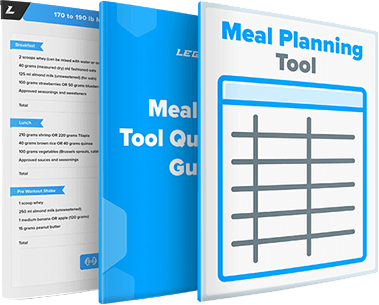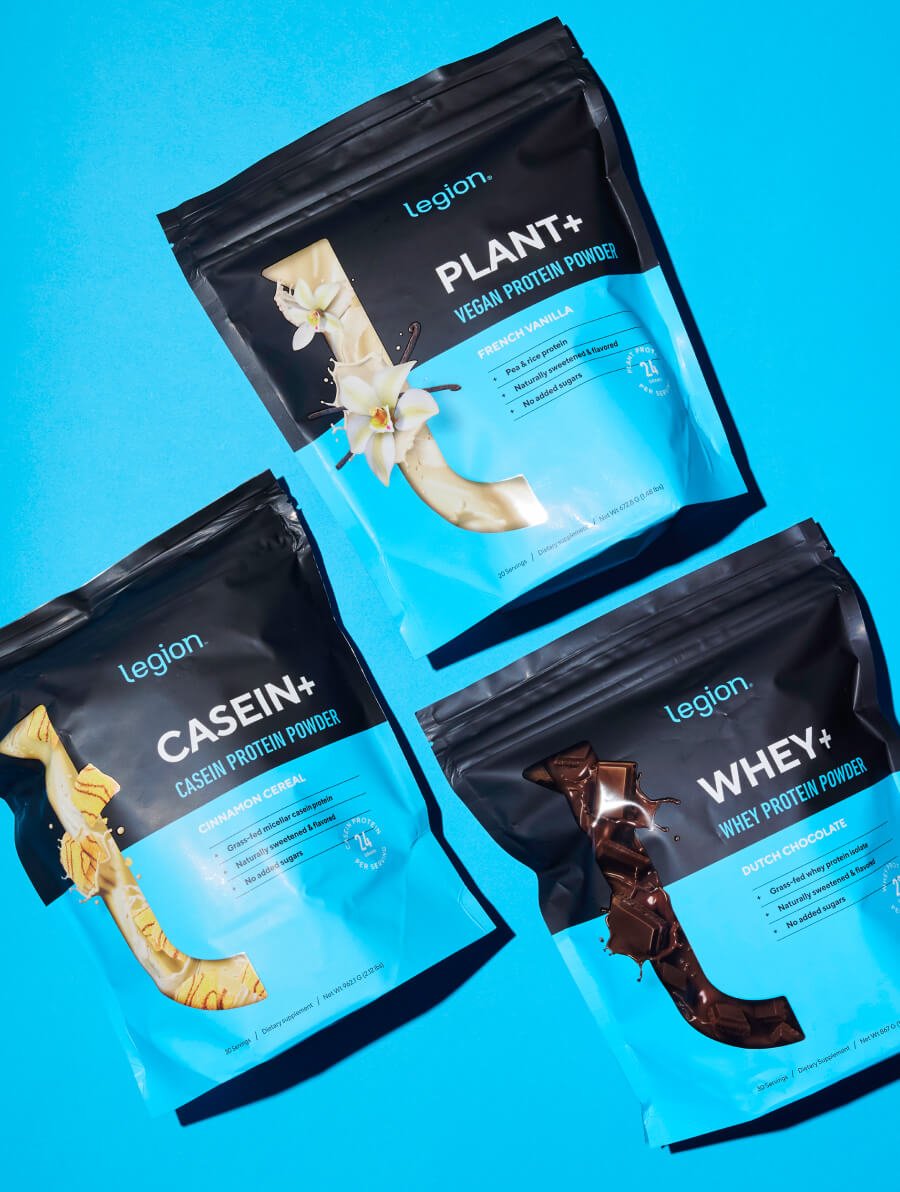Listen on Apple Podcasts | Listen on Spotify | Listen on YouTube
The number one reason people struggle to lose weight is they don’t stick to their diet.
Why?
Well, that’s the million dollar question.
Some people get bored with their food choices, lack of progress, and daily routine, and revert to their old eating habits.
Some people get thrown off course by a holiday, vacation, or unplanned restaurant outing and never pull themselves back on track.
Others try to lose weight too fast and end up running into a quicksand of low-energy, irritability, hunger, and obsessive thoughts about food that causes them to binge and gain back much of the weight they lost.
While those first two obstacles are relatively easy to solve, it’s that last one that’s often the bane of even the most experienced dieters.
Losing weight requires that you maintain a calorie deficit for weeks or months on end.
That is, you need to be eating fewer calories than you burn for quite some time to see a noticeable change in your appearance.
Most people have no trouble maintaining a calorie deficit for a few days or weeks, but it’s sticking it out day after day after day that wears people down and breaks their resolve.
And one of the key gremlins that plagues their progress is hunger.
There’s a lot you can do to counter hunger—eating more protein and fibrous fruits and vegetables, eating fewer processed foods, and (ironically) exercising, but if you diet for long enough it will become noticeable, especially between meals.
One of the things you can do to avoid being harried by hunger is taking natural appetite suppressants.
Now, appetite suppressants generally have a bad rap, and understandably so. Many harsh weight loss drugs like clenbuterol work partially because they also reduce appetite, and the most effective appetite suppressants often come with strong and potentially permanent side effects.
For example, while “clen” is an outstanding appetite suppressant, it also increases the risk of heart failure, potassium deficiency, and insomnia.
That said, it would be unfair to paint all appetite suppressants with the same brush as clenbuterol.
There are healthy, effective, natural appetite suppressants that can help you curb hunger and cravings without compromising your health.
While I’m an advocate of getting as much mileage out of your diet and training as possible before resorting to supplements, there are several kinds of natural appetite suppressants worth trying if you’re struggling to keep the hunger hobgoblins at bay.
And by the end of this podcast, you’ll know everything you need to know about which natural appetite suppressants are worth trying and which aren’t.
Let’s get started.
Mentioned on the show:
What did you think of this episode? Have anything else to share? Let me know in the comments below!
Transcript:
If you’ve ever struggled to lose weight or lose fat to be more specific or to maintain a body weight or a body composition, chances are you have struggled with hunger and appetite. And I understand I’ve been there myself and over the Years, I have heard from and worked with thousands of people and seen it firsthand.
And often what people experience is this, they are wanting to lose weight or lose fat. So they restrict their calories. And in the beginning for the first couple of weeks, things are smooth sailing. And in fact can even be enjoyable, especially if you’re coming off a lean bulking phase. For example, I remember the last time I really made a go at lean bulking, I was in a slight surplus, let’s say 10 or 15 percent above my TDE, my total daily energy expenditure for like.
I don’t know, four or five, maybe even six months. I don’t remember exactly. I’d have to look back into my, my training logs, but I do remember at the end of that lean bulking phase, I was eating upward of about 4, 000 calories per day. And I was so sick of eating food because I was force feeding myself.
Really? I mean, that is what overfeeding is. Your body does eventually just get sick of all the extra calories. That a cutting phase going into a deficit was, was a welcome respite from all of the overeating. I was looking forward to cutting. I couldn’t wait to cut actually. And then for the first couple weeks, it was nice to just eat a lot less food.
But then, as you get deeper into a cutting phase, for me, and for many of the people I’ve heard from over the years, somewhere around the one month mark, four, five weeks or so, once you reach that point, things change, and it is no longer enjoyable. You know, your energy levels start to dip, your mood starts to sour, your workouts suffer.
You usually at this point are going to be taking reps off of your big lifts or sometimes even weight off of the bar. You know, maybe you have to drop five or 10 pounds on your, on your big lifts. You have to drop down five or 10 pounds because you just don’t have it. And of course there is hunger and appetite.
Those two things are the most annoying obstacles to getting and staying lean. It just gets harder and harder to stick to your calories and macros. It takes more and more grit, more and more willpower. You have to suffer through more and more. And because of that, many people tend to overeat more often than they should.
And that means slower and slower results. And then that’s of course discouraging and demotivating because it means that you’re just going to have to diet for even longer. Eventually then, many people just fall off the wagon. They just give up on whatever their body composition goal was and figure… Maybe next time, and that’s why I wanted to talk about how to better control your hunger and appetite and share with you five effective and safe supplements.
You could say they’re not all supplements per se, like caffeine, for example, is not necessarily a supplement. That’s me. One of the things I’m going to talk about, but mostly we’ll just call them supplements for. Now, before we get to the show, if you like what I’m doing here on the podcast and elsewhere, and if you want to help me help more people get into the best shape of their lives, please do consider supporting my sports nutrition company, Legion Athletics, which produces 100 percent natural evidence based health and fitness supplements, including protein powders and protein bars, pre workout and post workout supplements.
fat burners, multivitamins, joint support, and more. Every ingredient and dose in every product of mine is backed by peer reviewed scientific research. Every formulation is 100 percent transparent, no proprietary blends, and everything is naturally sweetened and flavored. To check it out, just head over to legionathletics.
com. And just to show how much I appreciate my podcast peeps, use the coupon code M F L at checkout, and you will save 20 percent on your entire order if it is your first purchase with us. And if it is not your first purchase, then you will get double reward points on your entire order, which is essentially getting 10 percent cash back in rewards points.
So again, that URL is legionathletics. com. And if you appreciate. My work, and if you want to see more of it, please do consider supporting me so I can keep doing what I love, like producing podcasts like this. Let’s start with the fundamentals. So if you are in a calorie deficit or if you are just looking to maintain your body composition and you are struggling with overeating, you need to make sure that you’re eating enough protein.
Something around one gram per pound of body weight per day or around 40 percent of your calories. It can be a little less than that, but simple rule of thumb. You need to make sure that you are eating plenty of fibrous fruits and vegetables for a number of reasons, but controlling hunger and appetite is one of them.
And by plenty, I mean several servings of each per day. You want to eat plenty of whole, relatively unprocessed foods that of course goes hand in hand with fruits and vegetables, but that also includes things like whole grains and legumes and lean protein. Because that is going to also help keep you fuller.
So the more highly processed foods you eat, the more trouble you’re going to have with hunger and appetite. Generally speaking. And you also want to make sure that you are drinking enough. water, something around three quarters of a gallon per day is a good rule of thumb for most people. And you want to do that for health reasons, but also for helping curb hunger and appetite.
And lastly, you want to make sure that you’re sleeping enough. This is hugely important again for overall health and wellbeing, but also particularly. For hunger and appetite research shows that when we are not getting enough sleep, our body’s appetite hormones get out of whack. So there’s a hormone called Grelin that stimulates hunger.
There’s a hormone called leptin that stimulates satiety and fullness. And what happens is as we restrict sleep more and more, and this is something that. It’s an accumulative effect. If you don’t sleep well, one or two nights, you might notice a little bit of extra hunger, but it’s probably not going to be that big of a deal.
But if you are consistently not sleeping enough, your ghrelin levels are generally just going to be higher than normal, higher than they should be. And your leptin levels are generally going to be lower than normal, lower than they should be. And that is going to just produce more appetite and more hunger than normal.
Okay, so those are the basics. Those are the fundamentals. Let’s now shift toward the five extra things you can do. But first, I want to clarify hunger and appetite, because I’ve been separating those terms intentionally. So, hunger is the physical need to eat. It’s the physiological reaction to needing food.
If we don’t eat food, eventually we die. And so, hunger is the physical Whip that our body has to push us to go eat appetite. However, is slightly different. Appetite could be described as the emotional desire to eat, and that can be divorced from the physical need for calories. We’ve all been there before.
We’ve all found ourselves wanting food or just continuing to eat food, even though we’re Full, we definitely don’t need it, but physically we don’t need it, but emotionally we enjoy it or we desire it. So we eat it now in our modern world, the major problem that people run into relates to appetite more than hunger relates to the stimulation of the emotions related to eating and really just manipulation into wanting to eat more food.
For example, here in the West, the food industry is dominated by multibillion dollar companies that have collectively spent billions of dollars over the last number of decades, engineering foods to be as delicious and satisfying emotionally unfilling.
As possible, unsatisfying calorically as possible, many, many, many food scientists, and this is still a thing, of course, but, and what they’ve, what they’ve worked to do is figure out how to take foods like take a chip, a Dorito chip, and how to make the Dorito chip as pleasurable to eat. As possible, so that’s the flavor, of course, but it’s also the crunch when you bite into it.
It’s the experience while you’re chewing it. It’s the experience of swallowing it. Every little aspect of the chip is scrutinized and then tested again and again with different combinations of flavors and crunchiness and whatever else the food scientists can come up with to isolate. The most maximally pleasing chip as possible.
So that’s one element of the food engineering, but then there’s the other element of how to make it also as easy to overeat as possible, how to shortcut the brains. Systems for regulating calorie intake. So for example, a good story of this is the Cheeto and the guy who, who developed the Cheeto was so proud of his, his innovation because not only was the Cheeto perfect in terms of the flavor and the mouth feel what it was like to eat, but because it melted in your mouth, he found that that circumvented.
The brain’s systems for regulating calorie intake. So it made the Cheeto very easy to overeat. He found that because it melted like that, it didn’t register in the brain in the same way as regular foods. And so the result of this brilliant scientific breakthrough was a food that people could easily over consume.
So you had people who could plow through a bag of Cheetos, let’s say eat a thousand calories of Cheetos and then be hungry. Again, an hour later, and hopefully whoever owns cheat the Cheetos brand, uh, hungry for more Cheetos, go get another bag and go through that bag and get another bag and so forth. And so there are many, many, many foods out there that have been carefully engineered like this.
So that’s the product side of things. Many of these food products are carefully engineered. They’re created to encourage overconsumption. I wouldn’t say addiction because that model doesn’t really make sense in the context of food. I wouldn’t even say dependence. I would just say overconsumption. These foods are made to be very pleasurable and we are naturally drawn to do things that Give us pleasure.
And then there’s the marketing and the advertising side of things, because these big food companies have the money to work with the best marketers and the best advertisers in the world. And these people come up with very compelling marketing campaigns and advertisements to sell these foods to the masses.
And you know what I’m talking about. You’ve seen these advertisements. You’ve seen these marketing campaigns where you have complete shit food being sold as a wholesome and uplifting experience. You have, maybe it’s the family around the table eating the big pile of cheesy pasta and the kids are so happy and everyone’s laughing.
Or you have the diverse, trendy group of young people on the rooftop in Manhattan, drinking the Coke, laughing, uh, the, the colors are bright. They’re having such a good time, or maybe they’re eating McDonald’s food and they all are in shape and beautiful. Now you may think that Those types of marketing campaigns and those commercials don’t work on you, but they still can influence you subconsciously.
The underlying principles of persuasion are well established and it’s, it’s really, I would say probably 80 percent science at this point and 20%. Art and so when you are being constantly bombarded with those types of marketing messages, you may not go out and buy the pasta or buy the fast food, but it still can stimulate appetite.
It still can subconsciously just make you want to eat food. And so a good simple tip to start with when you are cutting or when you’re wanting to maintain body composition and struggling with overeating is to avoid that stuff. Try not to expose yourself to a bunch of food marketing and try not to have snacks lying around because if you see stuff, if you see delicious things lying around, The chances of you eating them go up.
Hey, if you like what I am doing here on the podcast and elsewhere, and if you want to help me help more people get into the best shape of their lives, please do consider supporting my sports nutrition company, Legion Athletics, which produces 100 percent natural evidence based health and fitness supplements, including protein powders and bars, pre workout and post workout supplements.
fat burners, multivitamins, joint support, and more. Every ingredient and every dose in every product is backed by peer reviewed scientific research. Every formulation is 100 percent transparent, there are no proprietary blends, and everything is naturally sweetened and flavored. To check Everything out just head over to legionathletics.
com and just to show how much I appreciate my podcast peeps use the coupon code MFL at checkout and you will save 20 percent on your entire order if it is your first purchase with us. And if it is not your first purchase with us, you will get double reward points on your entire order. That’s essentially 10 percent cash back in rewards points.
So again, the URL is legionathletics. com and if you appreciate my work and want to see more of it, please do consider supporting me so I can keep doing what I love, like producing podcasts like this. Okay, let’s now get to the five mostly supplements that you can add to everything else we’ve discussed to further blunt hunger and appetite.
And the first one is the obvious, uh, it is protein powder. And the reason for this is protein is filling. It’s the most filling of the three macronutrients. Protein, carbohydrate, and fat. Well, technically the term also includes a few of the minerals we need in large amounts, but whatever, in the context of dieting and flexible dieting, whenever we, whenever we say macros or macronutrients, we’re talking about protein, carbon fat, and out of those protein is the most filling.
And so what that means then is a high protein diet. It is pretty much always easier to stick to than a low protein one, and it has other benefits as well. But first and foremost, you are going to be hungry less often on a high protein diet, and that will also help keep your appetite down. And just to underscore how significant the effects can be in a study that was conducted by scientists at the University of Washington, switching people from a low protein diet to a high protein diet, reduced their calorie intake by about 500 calories per day on average.
And these were people who were being allowed to eat as much as they wanted to eat. So they weren’t being given meals in a lab. Because that, of course, then wouldn’t be impressive. They just cut the calories down. Oh, look at that. No, no. These are people who are being given guidelines on how to eat, but their meals weren’t being controlled by the researchers.
So under those conditions, simply switching from a low protein diet to a high protein diet. And then seeing a reduction of daily calorie intake by about 500 calories, which if you sustained would be about a pound of fat loss per week is impressive. Now why protein powder versus just eating more protein rich foods?
Uh, no particular reason. If you want to just eat more protein rich foods, you can do that as well. But protein powder makes it very easy to eat enough protein, which again, if you’re cutting in particular somewhere around a gram per pound of body weight per day of protein, or about 40 percent of your daily calories, that’s where you want to be.
And yes, you can get there just eating foods, but including a protein powder makes it. Very easy to do that because anyone can include, let’s say two to three scoops of protein powder per day in their meal plans easily, safely, healthily, and that’s, you know, 50 to 75 grams of protein right there. So you take that and add, let’s say two meals, uh, with another 30 to 50 grams of protein in each.
And you’re done for most people. That’s it. Your protein is covered. Another nice thing about high quality protein powders like mine over at legion athletics, way isolate. Or, uh, if we’re talking about plant based, a mix of rice and pea or casein, for example, we have a micellar casein is that a high quality protein powder is usually going to be more or less just protein.
There’s going to be very little carbohydrate and fat in each serving, which is what we want. We really just want protein from the powder. We’d rather. Eat our carbs and our fats. All right, next on the list is caffeine, and this is very simple. Caffeine is a stimulant. It raises levels of chemicals called catecholamines in your body, and these chemicals stimulate your metabolic rate.
So you burn more calories and they reduce hunger. Now, the problem with caffeine is your body becomes desensitized to it fairly quickly. So if you have caffeine every day, even if it’s not that much, let’s say it’s just a hundred, maybe 200 milligrams per day within, Oh, I’ve recorded some and written some stuff specifically on this, but if I’m remembering correctly within a week or two of having caffeine every day, it’s stimulatory effects become negligible.
Now it will continue to suppress tiredness. You never lose that from caffeine. But the stimulatory aspect of caffeine, it disappears quickly. And that’s why if you really want to get the most out of caffeine in terms of fat burning, hunger, and appetite reducing, and performance enhancement, You don’t want to have it every day.
Ideally, you would have a couple low and no caffeine days per week, and then a couple high caffeine days per week. That’s really the best way to do it. If you want to see again, the biggest boost in your workouts and the biggest boost in calorie burning and the biggest reduction in hunger and appetite.
That said, there is an interesting study that was conducted by scientists at Brooklyn College that found that decaffeinated coffee actually produced a larger reduction appetite than caffeinated coffee. And scientists aren’t exactly sure why that is, but it was an effect that was observed in a well designed study.
So technically then what you could do if you wanted to maximize the reduction in hunger and appetite without giving up the stimulatory effects of caffeine without giving up the metabolic boost and the performance enhancement and also the fat burning boost. You could have decaffeinated coffee several days per week, and then you could have either caffeinated coffee or pre workout or supplement with caffeine pills if you want a couple days per week.
And I would do it before workouts, like before heavy, hard workouts, maybe before your heavy, Pull workout, you know, deadlifting or maybe a heavy squat workout have somewhere around three to six milligrams of caffeine per kilogram of body weight in one go and enjoy the, the, the performance enhancement that comes with it and you’ll burn a bit more calories that day and you’ll have the reduction in hunger and appetite as well.
Okay, next up is 5 HTP, which is an amino acid that is involved in the creation of the neurotransmitter serotonin, which produces feelings of happiness. Now, higher levels of serotonin can lead to lower levels of food intake. And so it’s not surprising then that research has shown that when you supplement 5 HTP with meals, it can lead to greater feelings of fullness and less hunger and even less cravings for carbohydrate in particular.
And that then of course can naturally lead to lower calorie intakes. Now the clinically effective range of 5 HTP is 100 to 500 milligrams and you can buy it as a standalone supplement, pills, or even in bulk if you feel like measuring out milligrams. Or you can also get it in my fat burner Phoenix, which you can find over at legionathletics.
com. Okay, next up on the list here for reducing hunger and appetite is Now this is a chemical that’s found naturally. In citrus fruits and certain citrus fruits, and it’s chemically similar to a fedron. It’s like a natural version of a fedron. And sinephrine is a neat little molecule for losing fat for the same reasons that a fedron.
Is it’s not as strong as a Fedrin, but it has very similar effects in the body. So it’s a stimulant, it raises metabolic rate, it raises the production of catecholamines, like, like how caffeine does, which then reduces hunger and reduces appetite. Now, research shows that sinephrine also increases lipolysis, which is the process whereby fat cells release their stored energy.
to be burned. Cinephrine also increases the thermic effect of food, which is the amount of energy that it costs to digest and process and absorb the food that you eat. And lastly, cinephrine also blocks the activity of certain receptors in fat cells that can just slow down the process of fat loss. I know that sounds kind of bro scientific and like marketing.
Puffery, but, uh, it is a scientific fact. And if you want to learn more about that in particular, just search legion athletics, stubborn fat, and you’ll find an article that I wrote. I think I recorded a podcast. I must’ve recorded a podcast on it as well. Probably something on my YouTube channel as well, but you’ll find things that I created that explain the actual, the, the mechanisms behind what I just alluded to.
Now, yet another neat thing about Sinephrine is research shows that it works synergistically with caffeine to enhance both caffeines and its own fat loss benefits. So it really is a perfect addition to any fat loss supplement stack. Now, how much should you be taking? What’s the clinically effective range for snephrin?
It is 25 to 50 milligrams per day. That’s the general recommendation. That’s what you’ll find in most research. And again, you can buy it as a standalone supplement pills only. I would assume I wouldn’t. Want to get it bulk. I wouldn’t wanna be measuring out such tiny amounts and accidentally over measure and then have problems.
Or you can get it in the the fat loss supplement of mine that I mentioned earlier. Phoenix. Phoenix contains both five HTP and Synephrine and other things. And again, that’s [email protected]. All right. Last up on the list is yo him bean. And this is a chemical that is extracted from an African plant called the yo him be plant.
And it’s a rather unique fat loss molecule because not only is it a stimulant, so it’s going to raise metabolic rate, it’s going to raise catecholamine production, which naturally brings hunger and appetite down. It also blocks the activity of certain receptors on fat cells that put the brakes on fat loss that make it much harder to lose to shrink.
I see when you say lose fat, really what you’re doing is you’re shrinking fat cells. You’re not losing them. You’re not destroying them. You’re just shrinking them. And there are many. Uh, fat cells in your body that are resistant to the effects of catecholamines to your body’s natural fat burning chemicals that, uh, attached to fat cells and then trigger the release of the stored energy.
And that really is the major reason. Why we have quote unquote, stubborn fat, why are there just certain areas of our body that seem very resistant to fat loss are our eyes and our minds are not playing tricks on us. That really is the case. And for guys, what is it? Oh, it’s the lower abdomen area. That’s where you’ll usually find a high amount of these very resistant fat cells in, in women.
Any woman can tell you it’s her hips. It’s her thighs. It’s her butt. And so through this unique mechanism, which Sinephrine has as well, Yohimbine can help you lose stubborn fat faster. Now another cool thing about Yohimbine is it doesn’t lose effectiveness over time. Your body does not become desensitized to it.
It just always works. Now, as far as how to use yohimbine effectively first, there’s the dose, which is the clinically effective dose is 0. 1 to 0. 2 milligrams per kilogram of body weight. And that would be one serving. Now when I’m cutting and I’m using yohimbine, I’m having just one serving per day. I’m having it first thing in the morning when I was younger and my body was.
Less sensitive to stimulants. I would have two servings per day. I would have one serving in the morning before I would lift. And then I would have one serving later before cardio. And I’d usually do cardio. I want to say six or 7 PM. And at that time. I was able to have some caffeine, which just further, uh, it boosts your him beans effects.
So combining with caffeine is a good idea for losing even more fat. So I would have some caffeine in the morning with your him bean before lifting. And then some caffeine, I want to say about 150 to 175 milligrams I would have, uh, also later in toward, toward the evening before my cardio and I would sleep totally fine.
I can’t do that now. If I were to do that, I would probably not sleep at all. So you’d have to see how your body responds, but I should add in reference to caffeine in particular. And you’ll hit me and wouldn’t necessarily have the same effects, but with caffeine, I do recommend stopping your, your intake at least six hours before bedtime.
And I know it’s the standard recommendation, but there’s a reason why it’s. The standard recommendation just because you can have caffeine at 8 p. m. fall asleep and stay asleep doesn’t mean that your sleep is as good as it could be or even should be. Caffeine can impair sleep quality without making it entirely obvious to you.
You, again, you might have no trouble falling asleep. And staying asleep, but wake up less rested than you could or should be simply because of the caffeine that you had a few hours before bed. All right. Last couple odds and ends with yohimbine that you should know. One is if you have issues related to anxiety, I do not recommend you take it because it can make them worse.
Worse, and some people do not respond well to him being some people feel anxious when they take it and they get jittery if that’s the case, and you’ve been using it consistently for, let’s say, a week, and that’s still happening, then it’s not for you and very important. It does not work. You him being loses its loss benefits.
When insulin levels are elevated, which means that you must use it in a fasted state, your insulin levels must be at a low baseline level for your him being to help you lose fat and lose stubborn fat faster. Now, if you’re not sure what I mean by that fasted, what is that you’ve probably heard of that.
But if you don’t know exactly what that is, like, for example, many people think that me fasted just means, oh, I have an empty stomach and that’s not what it means. Yes, your stomach will be empty, but it’s a bit more than that. Just search Legion athletics, fasted exercise or fasted cardio, and you’ll find an article podcast and probably a video.
I think I’ve done all three on what fasted training is and why I do think it should be considered when you’re cutting. If you want to maximize fat loss, and particularly because you can add supplements like you have him being to it and get faster results. Oh, and last, last, last with, with your hand being is you can buy it as a standalone supplement.
And I believe it normally comes in 10 milligram pills, so you can then dose it accordingly, or you can find it in my fat loss product called forge, not Phoenix, but forge. And that is particularly a pre workout fat burners. What I call it to make it clear that it needs to be. Use in a fasted state and most people are taking it before a workout before a morning workout in particular That’s really the easiest way to use yohimbine effectively wake up do your thing?
Drink some water have some caffeine have some yohimbine Workout and then eat after. All right, well that’s it for today’s episode. I hope you found it interesting and helpful. And if you did and you don’t mind doing me a favor, could you please leave a quick review for the podcast on iTunes or wherever?
You are listening from because those reviews not only convince people that they should check out the show. They also increase the search visibility and help more people find their way to me and to the podcast and learn how to build their best body ever. As well. And of course, if you want to be notified when the next episode goes live, then simply subscribe to the podcast and whatever app you’re using to listen and you will not miss out on any of the new stuff that I have coming.
And last, if you didn’t like something about the show, then definitely shoot me an email at Mike at muscle for life. com and share your thoughts. Let me know how you think I could do this better. I read every email myself, and I’m always. Looking for constructive feedback. All right. Thanks again for listening to this episode, and I hope to hear from you soon.
Scientific References +
- Cimolai N, Cimolai T. Yohimbine use for physical enhancement and its potential toxicity. J Diet Suppl. 2011;8(4):346-354. doi:10.3109/19390211.2011.615806
- Ergogenic Effects of Yohimbine: Standardized Cycling… Ergogenic Effects of Yohimbine: Standardized Cycling Clinical Study. https://www.researchgate.net/publication/273061682_Ergogenic_Effects_of_Yohimbine_Standardized_Cycling_Ergogenic_Effects_of_Yohimbine_Standardized_Cycling_Clinical_Study. Accessed April 8, 2020.
- Strosberg AD. Structure, function, and regulation of adrenergic receptors. Protein Sci. 1993;2(8):1198-1209. doi:10.1002/pro.5560020802
- Ostojic SM. Yohimbine: The effects on body composition and exercise performance in soccer players. Res Sport Med. 2006;14(4):289-299. doi:10.1080/15438620600987106
- Seifert JG, Nelson A, Devonish J, Burke ER, Stohs SJ. Effect of acute administration of an herbal preparation on blood pressure and heart rate in humans. Int J Med Sci. 2011;8(3):192-197. doi:10.7150/ijms.8.192
- Gougeon R, Harrigan K, Tremblay JF, Hedrei P, Lamarche M, Morais JA. Increase in the thermic effect of food in women by adrenergic amines extracted from citrus aurantium. Obes Res. 2005;13(7):1187-1194. doi:10.1038/oby.2005.141
- Haaz S, Fontaine KR, Cutter G, Limdi N, Perumean-Chaney S, Allison DB. Citrus aurantium and synephrine alkaloids in the treatment of overweight and obesity: An update. Obes Rev. 2006;7(1):79-88. doi:10.1111/j.1467-789X.2006.00195.x
- Shekelle PG, Hardy ML, Morton SC, et al. Efficacy and Safety of Ephedra and Ephedrine for Weight Loss and Athletic Performance: A Meta-analysis. J Am Med Assoc. 2003;289(12):1537-1545. doi:10.1001/jama.289.12.1537
- Cangiano C, Ceci F, Cascino A, et al. Eating behavior and adherence to dietary prescriptions in obese adult subjects treated with 5-hydroxytryptophan. Am J Clin Nutr. 1992;56(5):863-867. doi:10.1093/ajcn/56.5.863
- Wurtman RJ, Wurtman JJ. Brain serotonin, carbohydrate-craving, obesity and depression. Obes Res. 1995;3 Suppl 4. https://www.ncbi.nlm.nih.gov/pubmed/8697046. Accessed April 8, 2020.
- Ceci F, Cangiano C, Cairella M, et al. The effects of oral 5-hydroxytryptophan administration on feeding behavior in obese adult female subjects. J Neural Transm. 1989;76(2):109-117. doi:10.1007/bf01578751
- Greenberg JA, Geliebter A. Coffee, hunger, and peptide yy. J Am Coll Nutr. 2012;31(3):160-166. doi:10.1080/07315724.2012.10720023
- King KS, Darmani NA, Hughes MS, Adams KT, Pacak K. Exercise-induced nausea and vomiting: Another sign and symptom of pheochromocytoma and paraganglioma. Endocrine. 2010;37(3):403-407. doi:10.1007/s12020-010-9319-3
- Bresch A, Rullmann M, Luthardt J, et al. Hunger and disinhibition but not cognitive restraint are associated with central norepinephrine transporter availability. Appetite. 2017;117:270-274. doi:10.1016/j.appet.2017.06.020
- Wilmore DW, Long JM, Mason AD, Skreen RW, Pruitt BA. Catecholamines: Mediator of the hypermetabolic response to thermal injury. Ann Surg. 1974;180(4):653-669. doi:10.1097/00000658-197410000-00031
- Bresch A, Rullmann M, Luthardt J, et al. Hunger and disinhibition but not cognitive restraint are associated with central norepinephrine transporter availability. Appetite. 2017;117:270-274. doi:10.1016/j.appet.2017.06.020
- Arciero PJ, Edmonds RC, Bunsawat K, et al. Protein-pacing from food or supplementation improves physical performance in overweight men and women: The PRISE 2 study. Nutrients. 2016;8(5). doi:10.3390/nu8050288
- Weigle D, Breen P, … CM-… A journal of, 2005 U. A high-protein diet induces sustained reductions in appetite, ad libitum caloric intake, and body we. Am J Clin Nutr. 2005;82(1):41-48. doi:10.1093/ajcn.82.1.41
- Chambers L, McCrickerd K, Yeomans MR. Optimising foods for satiety. Trends Food Sci Technol. 2015;41(2):149-160. doi:10.1016/j.tifs.2014.10.007
- Pesta DH, Samuel VT. A high-protein diet for reducing body fat: Mechanisms and possible caveats. Nutr Metab. 2014;11(1). doi:10.1186/1743-7075-11-53
- Leidy HJ, Clifton PM, Astrup A, et al. The role of protein in weight loss and maintenance. Am J Clin Nutr. 2015;101(6):1320S-1329S. doi:10.3945/ajcn.114.084038
- Westerterp-Plantenga MS, Lemmens SG, Westerterp KR. Dietary protein - Its role in satiety, energetics, weight loss and health. Br J Nutr. 2012;108(SUPPL. 2). doi:10.1017/S0007114512002589
- Young LR, Nestle M. The contribution of expanding portion sizes to the US obesity epidemic. Am J Public Health. 2002;92(2):246-249. doi:10.2105/AJPH.92.2.246
- Thackray AE, Deighton K, King JA, Stensel DJ. Exercise, appetite and weight control: Are there differences between men and women? Nutrients. 2016;8(9). doi:10.3390/nu8090583
- Fardet A. Minimally processed foods are more satiating and less hyperglycemic than ultra-processed foods: A preliminary study with 98 ready-to-eat foods. Food Funct. 2016;7(5):2338-2346. doi:10.1039/c6fo00107f
- Clark MJ, Slavin JL. The effect of fiber on satiety and food intake: A systematic review. J Am Coll Nutr. 2013;32(3):200-211. doi:10.1080/07315724.2013.791194
- Gallagher D, Heymsfield SB, Heo M, Jebb SA, Murgatroyd PR, Sakamoto Y. Major dietary patterns are related to plasma concentrations ofmarkers of inflammation and endothelial dysfunction. Am J Clin Nutr. 2000;72(3):694-701. doi:10.1093/AJCN










